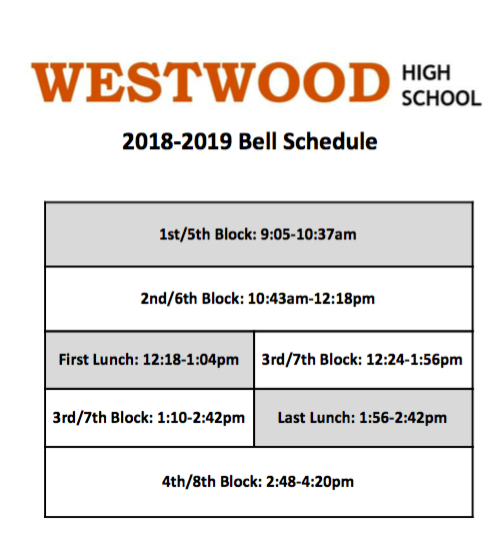Acosta Introduces Changes to Schedule, Admin
June 22, 2018
For the upcoming school year, Principal Mario Acosta has announced that Westwood will follow a two-lunch bell schedule with each lunch lasting about 45 minutes, while also having few minutes to get back to class. The layout and last-name assortment of alpha offices will change as well, with the addition of multiple assistant principals for alpha offices with a large student body and Warrior-themed nicknames for each office room.
The prospect of these changes have been apparent since last year; there were multiple days where Principal Acosta changed the schedule to test what would happen if B lunch students would go to A lunch instead. Satisfied with the result and feedback, he decided to go forward with the change.
“The main reason we decided to implement these changes was because students in B lunch had to move around to A or C lunch if they had a quiz or a test,” Principal Acosta said. “On a given day, there were already so few students in B lunch, and so, to even out the schedule, because of the extra five minutes added last year, we decided to move all the students. The group who would be the most affected, however, are the seniors because if they were all in C lunch, it would be empty and A lunch would be crowded so we will now have to divide them up across the lunches.”

Concerns about the changes to the bell schedule and the process and organization of having about 1,500 students in one lunch block also spread to the minds of students as well.
“I feel like the change is ridiculous and uncalled for,” Trevor Wyatt ‘19 said. “[but] if they distribute the kids evenly, it could work, but if they don’t, it will be cramped and not fun for anyone.”
While some students aren’t pleased with the changes, others are excited for a possible solution to the inconvenient B lunch.
“The change is something definitely something different from what we’ve previously done but I feel like it could be a good thing,” Anjali Suresh ‘20 said. “Firstly, there’s less bell disruptions and there’s a higher likelihood of having your friends during lunch. Also, I feel like class would be more fluid in the time perspective, enabling students and teachers to create a more efficient learning environment. Overall, I feel like this implementation could benefit students and teachers alike.”
Responding to students’ concerns, Principal Acosta reassures them by including brand new systems across the cafeteria, influenced by student feedback.
“Next year, we will be adding a new grab-and-go selection where the lunches will be pre-packaged so students can grab it and go where they need to go and the cafeteria doesn’t feel overcrowded,” Principal Acosta said. “We are also implementing new sections to Java City and planning to buy more microwaves to alleviate the lines. Finally, we are also adding tables to the back of the cafeteria, near the spot where it goes down to make more space to sit. With all of these changes, I think that the problem can be solved.”
While the changes in the staff are geared more towards the management of the office, rather than the students, Principal Acosta kept students’ concerns in mind as he created this system.
“We are not changing the assigned counselors because I know students have strong bonds with them,” Principal Acosta said. “ [For example], if you have a sister or brother, you would have the same counselors as them so we didn’t change that. Two of our assistant principals had a lot of students in their office so the only thing we changed is dividing up the students between the offices. And although this change was mainly for my team of assistant principals, positives will definitely come out of it for students. Assistant principals will now have less students so they will be more available for when students need them.”
Although students will have to adapt to the new changes, Principal Acosta doesn’t plan to leave them with complaints. He is constantly looking for ways to improve, and with the feedback that will come once this plan is implemented, he hopes to better his solution with new additions and processes, all lead by the students.


